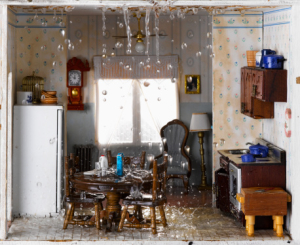Do you sneeze every morning after your shower? Does your bathroom floor feel a little soft in places? Does your throne feel a little bit like a rocking chair? These may be signs of hidden water damage that could affect your health and threaten the structural integrity of your home.
One of the most challenging parts of home ownership is knowing when a hidden problem is occurring – either in the electrical, plumbing or in other mechanical systems. Within your home’s bathroom, where the highest water usage occurs, the risk of water damage behind the walls and under the floor is higher than anywhere else in the house.
When moisture gets under the tub or shower basin, or between the shower liner and the wall, it encourages mold and mildew to form which eventually leads to wood rot in walls and the subfloor. In the worst-case scenario, the damage is so severe that the floor gives way, sending the bath tub, toilet or shower stall crashing down to the floor below.
Here are 5 signs you may have bathroom water damage:
Musty smell – If you have a persistent, musty, damp smell in your bathroom, even after repeated cleanings, you may have mold and mildew in the walls and subfloor. If a proper ventilation system doesn’t help, you probably have a moisture build up below the surface of walls or the floor.
Recurrent mold and mildew on bathroom surfaces – Broken tiles, decaying grout or caulk and poor waterproofing may lead to moisture forming behind the tile, painted surfaces and wallboard. Since the mold and mildew are actually growing from the inside out, repeated scrubbings won’t help this problem. Another test for water damage – if you push gently on the tiles or wallboard and feel some movement, there’s water damage you need to address.
Warped walls – When drywall is subject to moisture, it becomes soft and begins to bubble. If not properly protected, eventually it will warp and break into smaller pieces.
Gaps between caulk, tub and tile – If you have gaps in your grout or caulk, shower spray or bath water may be seeping into the walls and subfloor, causing mold, mildew and wood rot.
Spongy or soft floor – If your home was built with a wooden floor truss system, the sub floor is usually made of plywood, which forms the actual floor of your home. If this material is subject to moisture or hidden leaks, the plywood will rot and the floor will start to feel soft or spongy in places. Your toilet may also feel unstable (rocking) when you sit down. If left unattended, eventually the entire flooring system under the bathroom will collapse.
If you notice any of these issues in your bathroom, you should have them checked out by a professional. Don’t delay. There may be steps you can take to repair or reduce the damage. Or, you may need bathroom remodeling to replace the damaged materials. Procrastinating or attempting to hide the problem with a cosmetic fix will only delay the inevitable and end up costing you more.
As always, before you hire a contractor to work on your home, learn the right questions to ask by downloading our FREE Guide, the Iowa Contractor Comparison Guide – How to Make Your Remodeling Project a Success for tips on hiring the right local contractor.







